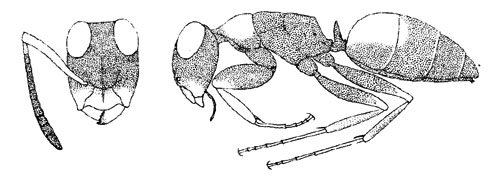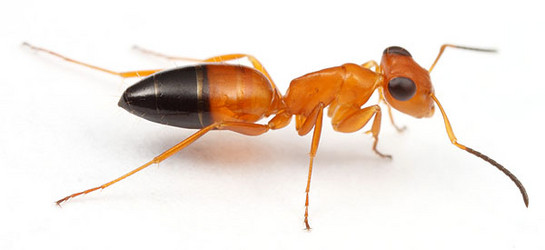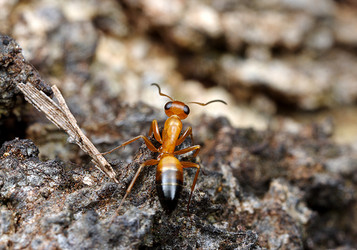Opisthopsis
Strobe Ants
Alex Wild- Opisthopsis diadematus
- Opisthopsis haddoni
- Opisthopsis halmaherae
- Opisthopsis jocosus
- Opisthopsis lienosus
- Opisthopsis linnaei
- Opisthopsis major
- Opisthopsis manni
- Opisthopsis maurus
- Opisthopsis panops
- Opisthopsis pictus
- Opisthopsis respiciens
- Opisthopsis rufithorax
Introduction
The camponotine genus Opisthopsis is restricted to the Australian and Papuan region, where it is among the most recognizable ants. These colorful, large-eyed insects are abundant in many habitats from dry savannah to rain forest, foraging conspicuously above ground and on vegetation. The name "strobe ant" refers to the workers' distinctly erratic movements.
Colonies are small to moderate in size with no more than a few hundred workers. Nest site differs among species and can be either in soil or in trees. At least one species, O. haddoni, shows an affinity for termite mounds (Wheeler, 1918).
Characteristics
The camponotine genus Opisthopsis is recognized in the worker caste by the following combination of characters:
- Compound eyes large, bulging, and prominently placed at the rear of the head such that in full-face view they form the postero-lateral margin.
- Mandibles triangular and bearing 5 teeth on masticatory margin.
- Propodeum in lateral view raised, reaching the level of mesonotum such that profile of mesosoma often forms a single convexity.
- Pubescence on surface of body sparse; surface smooth and often shining.
- Metapleural gland present.


Opisthopsis respiciens worker. Note the placement of the eyes, diagnostic for the genus.
In the field, Opisthopsis runs with a characteristic jerky gait and is capable of sudden sideways movements. Most species are brightly colored, bearing contrasting black and orange or yellow patterns. Their excellent eyesight in nearly all directions renders them difficult to approach.
Discussion of Phylogenetic Relationships
Opisthopsis is almost certainly monophyletic. All species share the unique derived position of the eyes as well as a general similarity in body proportion, sculpture, and pilosity. Molecular analyses of three species and their bacterial Blochmannia endosymbionts also support the monophyly of at least those samples, as well as the placement of Opisthopsis within the camponotini (Wernegreen et al, 2009), for which the association with Blochmannia appears to be a key synapomorphy. The position of the antennal insertions removed posteriad from the clypeus and the elongate structure of the proventriculus also associate Opisthopsis with camponotini (Wheeler, 1918).
Relationships among the 13 nominal species have yet to be studied.
References
Bolton, B. 2003. Synopsis and Classification of Formicidae. 370 pp. Memoirs of the American Entomological Institute, Vol. 71. Gainesville, FL.
Shattuck, S. 1999. Australian Ants, Their Biology and Identification. CSIRO publishing. Victoria, Australia.
Wernegreen, J. J., S. N. Kauppinen, S. G. Brady, and P. S. Ward 2009. One nutritional symbiosis begat another: phylogenetic evidence that the ant tribe Camponotini acquired Blochmannia by tending sap-feeding insects. BMC Evol Biol. 9: 292.
Wheeler, W. M. 1918. Ants of the Genus Opisthopsis Emery. Bull. Mus. Comp. Zool. 62: 341-362.
Title Illustrations

| Scientific Name | Opisthopsis haddoni |
|---|---|
| Location | Darwin, NT, Australia |
| Specimen Condition | Live Specimen |
| Identified By | Alex Wild |
| Sex | worker |
| Life Cycle Stage | adult |
| View | lateral |
| Size | 5mm |
| Copyright |
© Alex Wild

|
About This Page
Alex Wild

University of Illinois, Urbana, Illinois, USA
Correspondence regarding this page should be directed to Alex Wild at
Page copyright © 2010 Alex Wild
All Rights Reserved.
- First online 11 September 2004
- Content changed 23 September 2010
Citing this page:
Wild, Alex. 2010. Opisthopsis. Strobe Ants. Version 23 September 2010. http://tolweb.org/Opisthopsis/22320/2010.09.23 in The Tree of Life Web Project, http://tolweb.org/










 Go to quick links
Go to quick search
Go to navigation for this section of the ToL site
Go to detailed links for the ToL site
Go to quick links
Go to quick search
Go to navigation for this section of the ToL site
Go to detailed links for the ToL site